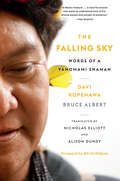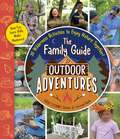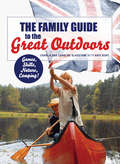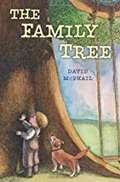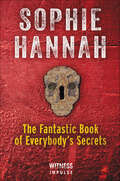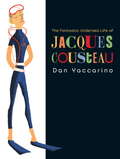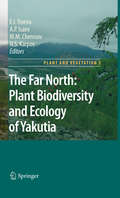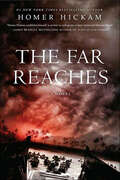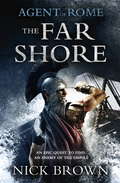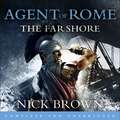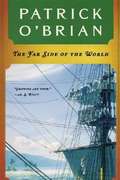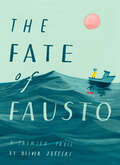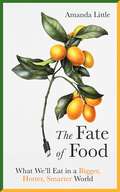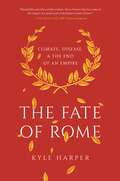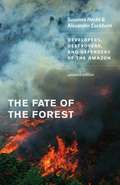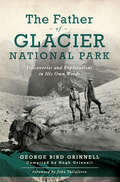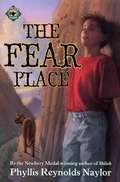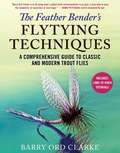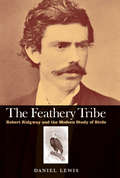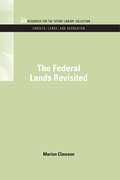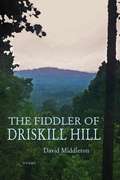- Table View
- List View
The Falling Sky: Words of a Yanomami Shaman
by Davi Kopenawa Bruce AlbertThe 10th anniversary editionA Guardian Best Book about DeforestationA New Scientist Best Book of the YearA Taipei Times Best Book of the Year“A perfectly grounded account of what it is like to live an indigenous life in communion with one’s personal spirits. We are losing worlds upon worlds.”—Louise Erdrich, New York Times Book Review“The Yanomami of the Amazon, like all the indigenous peoples of the Americas and Australia, have experienced the end of what was once their world. Yet they have survived and somehow succeeded in making sense of a wounded existence. They have a lot to teach us.”—Amitav Ghosh, The Guardian“A literary treasure…a must for anyone who wants to understand more of the diverse beauty and wonder of existence.”—New ScientistA now classic account of the life and thought of Davi Kopenawa, shaman and spokesman for the Yanomami, The Falling Sky paints an unforgettable picture of an indigenous culture living in harmony with the Amazon forest and its creatures, and its devastating encounter with the global mining industry. In richly evocative language, Kopenawa recounts his initiation as a shaman and first experience of outsiders: missionaries, cattle ranchers, government officials, and gold prospectors seeking to extract the riches of the Amazon.A coming-of-age story entwined with a rare first-person articulation of shamanic philosophy, this impassioned plea to respect indigenous peoples’ rights is a powerful rebuke to the accelerating depredation of the Amazon and other natural treasures threatened by climate change and development.
The Family Guide to Outdoor Adventures: 30 Wilderness Activities to Enjoy Nature Together!
by Creek StewartExplore and experience nature with your kids with these 30 fun and educational family activities dedicated to spending more time outside.Less screen, more green! In the world of smartphones, tablets, and online learning, the need for children to engage with nature has never been more evident. Outdoor activities and projects inspire exploration, creativity, curiosity, learning, and a sense of wonder. Interacting with nature also fosters a healthy love and respect for the outdoors. The Family Guide to Outdoor Adventures features fun and engaging hands-on nature, camping, and bushcraft projects that get you and your children outside having more fun, strengthening your bond, and creating memories that will last a lifetime. Written by expert survival instructor Creek Stewart, each project is designed to get parents and their kids outside and teach them about nature and the great outdoors. From casting animal tracks and dyeing t-shirts with walnuts to building a debris hut and catching minnows with a spider web your family with get your hands dirty, learn some cool nature facts, and complete some awesome projects with your family. Explore, create, laugh, love, and experience the great outdoors together with The Family Guide to Outdoor Adventures.
The Family Guide to the Great Outdoors
by Charlie GladstoneGetting outdoors brings the whole family together. You’ll learn skills, have a run-around, share laughs, and make enduring memories.This book is the perfect companion to any outdoor family adventure. From countryside camping holidays to weekends roaming fields and parks, it will inspire you to enjoy the outdoors whatever the weather. It covers everything for kids (and big kids) to do outdoors, including:- Cloud identification- Great British walks- Building dams and dens- Campfires and woods- Camping recipes- Common British trees
The Family Tree
by David McPhailA man in the 1800s comes upon a beautiful forest and decides to build his home there. When he clears the land, he leaves one special tree to grace his front yard. Over the years, several generations of his family enjoy this tree, but it is endangered by a plan to build a highway. A young boy and his host of animal friends get together to make a stand, and give back to the tree which has given them so much. With lavish illustrations and very few words, David McPhail delivers a timeless environmental message and a heartwarming story for ages 4 to 8.
The Fantastic Book of Everybody's Secrets
by Sophie HannahEverybody has their secrets. Who, for instance, is the hooded figure hiding in the bushes outside a young man’s house? Why does the same stranger keep appearing in the background of a family’s holiday photographs? What makes a woman stand mesmerized by two children in a school playground—children she’s never met but whose names she knows well? All will be revealed . . . but at a cost. As Sophie Hannah uncovers the dark obsessions and strange longings behind the most ordinary relationships, life will never seem quite the same again.
The Fantastic Undersea Life of Jacques Cousteau
by Dan YaccarinoJacques Cousteau was the world's ambassador of the oceans. His popular TV series brought whales, otters, and dolphins right into people's living rooms. Now, in this exciting picturebook biography, Dan Yaccarino introduces young readers to the man behind the snorkel.From the first moment he got a glimpse of what lived under the ocean's waves, Cousteau was hooked. And so he set sail aboard the Calypso to see the sea. He and his team of scientists invented diving equipment and waterproof cameras. They made films and televisions shows and wrote books so they could share what they learned. The oceans were a vast unexplored world, and Cousteau became our guide. And when he saw that pollution was taking its toll on the seas, Cousteau became our guide in how to protect the oceans as well.
The Far North:
by A. P. Isaev Elena I. Troeva M. M. Cherosov N. S. KarpovOutside Russia very little is known about the terrestrial ecology, vegetation, biogeographical patterns, and biodiversity of the enormously extensive ecosystems of Yakutia, Siberia. These systems are very special in that they function on top of huge layers of permafrost and are exposed to very severe and extreme weather conditions, the range between winter and summer temperatures being more than 100 degrees C. The soils are generally poor, and human use of the vegetation is usually extensive. Main vegetation zones are taiga and tundra, but Yakutia also supports a special land and vegetation form, caused by permafrost, the alas: more or less extensive grasslands around roundish lakes in taiga. All these vegetation types will be described and their ecology and ecophysiological characteristics will be dealt with. Because of the size of Yakutia, covering several climatic zones, and its extreme position on ecological gradients, Yakutia contains very interesting biogeographical patterns, which also will be described. Our analyses are drawn from many years of research in Yakutia and from a vast body of ecological and other literature in Russian publications and in unpublished local reports. The anthropogenic influence on the ecosystems will be dealt with. This includes the main activities of human interference with nature: forestry, extensive reindeer herding, cattle and horse grazing, etc. Also fire and other prominent ecological factors are dealt with. A very important point is also the very high degree of naturalness that is still extant in Yakutia's main vegetation zones.
The Far Reaches: A Novel (Josh Thurlow #3)
by Homer HickamThe year is 1943 and World War II in the Pacific rages on, with Americans engaged in desperate battles against a cunning enemy. Coast Guard Captain Josh Thurlow is on hand at the invasion of Tarawa, as the U.S. Navy begins the grand strategy of throwing her marines at island after bloody island across the Pacific. But nothing goes as planned as young Americans go up against fanatical defenders, who revel in snipers, big guns, and human wave attacks from which there is no escape save death. As blood colors the waters around Tarawa, Josh flounders ashore through a floating graveyard of dead men and joins the survivors, determined to somehow wrest victory from disaster. Critically wounded, ,Josh expects to die. Instead, he is spun off on one of his greatest adventures when Sister Mary Kathleen, a young Irish nun, nurses him back to health, then shanghais Josh, sidekick Bosun Ready O'Neal, and three American marines to a group of beautiful tropical islands invaded by a brutal Japanese warlord. Josh and his little band must decide whether to help the Sister fight the battle she demands, return to Tarawa and the "real" war, or settle down in the romantic splendor of the South Seas. Hickam expertly weaves the adventures of these hot-blooded characters tighter and tighter until the Sister's secrets and sins are finally revealed during a horrific battle in the lair of the warlord. With an incredible eye for historical detail and the talent of a master storyteller, Homer Hickam delivers another tour de force.
The Far Shore: Agent of Rome 3
by Nick BrownWhen the deputy commander of Rome's Imperial Security Service is assassinated on the island of Rhodes, Cassius Corbulo swiftly finds himself embroiled in the investigation. Assisted once more by ex-gladiator bodyguard Indavara and servant Simo, his search for the truth is complicated by the involvement of the dead man's headstrong daughter, Annia. Braving hostile seas, Cassius and his allies follow the assassin's trail south aboard a ship captained by a roguish Carthaginian smuggler and manned by his disparate, dangerous crew. Their journey leads them to the farthest reaches of the empire; to a ruined city where the rules of Roman civilization have long been abandoned, and a deadly battle of wits with a brutal, relentless foe.
The Far Shore: Agent of Rome 3
by Nick BrownWhen the deputy commander of Rome's Imperial Security Service is assassinated on the island of Rhodes, Cassius Corbulo swiftly finds himself embroiled in the investigation. Assisted once more by ex-gladiator bodyguard Indavara and servant Simo, his search for the truth is complicated by the involvement of the dead man's headstrong daughter, Annia. Braving hostile seas, Cassius and his allies follow the assassin's trail south aboard a ship captained by a roguish Carthaginian smuggler and manned by his disparate, dangerous crew. Their journey leads them to the farthest reaches of the empire; to a ruined city where the rules of Roman civilization have long been abandoned, and a deadly battle of wits with a brutal, relentless foe.
The Far Shore: Agent of Rome 3 (Agent of Rome #3)
by Nick BrownWhen the deputy commander of Rome's Imperial Security Service is assassinated on the island of Rhodes, Cassius Corbulo swiftly finds himself embroiled in the investigation. Assisted once more by ex-gladiator bodyguard Indavara and servant Simo, his search for the truth is complicated by the involvement of the dead man's headstrong daughter, Annia. Braving hostile seas, Cassius and his allies follow the assassin's trail south aboard a ship captained by a roguish Carthaginian smuggler and manned by his disparate, dangerous crew. Their journey leads them to the farthest reaches of the empire; to a ruined city where the rules of Roman civilization have long been abandoned, and a deadly battle of wits with a brutal, relentless foe.(P)2013 Hodder & Stoughton
The Far Side of the World
by Patrick O'BrianJack Aubrey sets course for Cape Horn on a mission. Little does he and Maturin know that disasters await them in the Great South Sea: typhoons, shipwrecks, murder, and criminal insanity.
The FarmMade Essential Skills Book: Handmade Projects from America's Farmers
by Patti Johnson-Long FarmMadeA celebration of simple living skills. Not too long ago, handwork skills such as sewing a quilt, crocheting a washcloth, or embroidering a pillowcase were handed down from one generation to the next. Candle- and soap-making, blacksmithing, basket weaving, natural yarn dying, and repurposing were all time-honored traditions that were essential to the farm&’s microeconomy and long-term success. While many of these traditional skills have been lost to the convenience of today&’s modern economy, they are still alive and thriving among America&’s farmers. The FarmMade Essential Skills Book showcases fifty authentic projects from farms all over the country. Hailing from New England, the Deep South, the Midwest, Southwest, and Northwest, each farm-made project represents its region&’s unique array of raw materials and end products. Revive valuable lost traditions and pave the way for a more independent, sustainable future with The FarmMade Essential Skills Book.
The Fascinating Human Body Book for Kids: 500 Phenomenal Facts! (Fascinating Facts)
by Donna M. BozzoneExplore the human body from head to toe with fun facts for ages 9 to 12 Human bodies come in many different shapes, sizes, and colors, but we're all put together the same way! The Fascinating Human Body Book for Kids shows kids how the body works with 500 anatomy facts that offer hours of fun and learning. This colorful book on the human body for kids is packed with weird and wonderful information about the five senses, the digestive system, and every organ. This book on the human body for kids is packed with facts like:Your brain generates more than 20 watts of energy—enough to power a light bulb. The record for a person having uninterrupted hiccups is 68 years.When you whisper, you are talking without using your vocal cords.Give kids a head start to learning with this exploration of the human body for kids.
The Fate of Fausto: A Painted Fable
by Oliver JeffersA TIME Best Children's Book of 2019!A Chicago Public Library 2019 Best of the Best Book!*"This minimalistic masterpiece is a must-read for all ages." --School Library Journal (starred review!)A quirky, cautionary tale from beloved New York Times bestselling picture book creator Oliver Jeffers!There was once a man who believed he owned everything and set out to survey what was his."You are mine," Fausto said to the flower, the sheep, and the mountain, and they all bowed before him. But they were not enough for Fausto, so he conquered a boat and set out to sea . . .Combining bold art and powerful prose, and working in traditional lithographic printmaking techniques for the first time, world-renowned talent Oliver Jeffers has created a poignant modern-day fable to touch the hearts of adults and children alike.Praise for The Fate of Fausto:"Jeffers paints Fausto and the objects of his desire with the nonchalant finesse he is known for and in the richly saturated colors he generally favors... Jeffers delivers swift justice in a few concluding words that make for an ending that satisfies for being both fair-minded and irrevocable."--New York Times Book Review"Boldly conceived and gracefully executed."--Publishers Weekly"A parable sure to spark lively discussions." --Booklist"A cautionary fable on the banality of belligerence." --Kirkus Reviews
The Fate of Food: What We’ll Eat in a Bigger, Hotter, Smarter World
by Amanda LittleIs the future of food looking bleak – or better than ever? At a time when every day brings news of drought and famine, Amanda Little investigates what it will take to feed a hotter, hungrier, more crowded world. She explores the past along with the present and discovers startling innovations: remote-control crops, vertical farms, robot weedkillers, lab-grown meat, 3D-printed meals, water networks run by supercomputers, cloud seeding and sensors that monitor the microclimate of individual plants. She meets the creative and controversial minds changing the face of modern food production, and tackles fears over genetic modification with hard facts. The Fate of Food is a fascinating look at the threats and opportunities that lie ahead as we struggle for food security. Faced with a perilous future, it gives us reason to hope.
The Fate of Rome: Climate, Disease, and the End of an Empire (The\princeton History Of The Ancient World Ser. #2)
by Kyle HarperA sweeping new history of how climate change and disease helped bring down the Roman EmpireHere is the monumental retelling of one of the most consequential chapters of human history: the fall of the Roman Empire. The Fate of Rome is the first book to examine the catastrophic role that climate change and infectious diseases played in the collapse of Rome’s power—a story of nature’s triumph over human ambition.Interweaving a grand historical narrative with cutting-edge climate science and genetic discoveries, Kyle Harper traces how the fate of Rome was decided not just by emperors, soldiers, and barbarians but also by volcanic eruptions, solar cycles, climate instability, and devastating viruses and bacteria. He takes readers from Rome’s pinnacle in the second century, when the empire seemed an invincible superpower, to its unraveling by the seventh century, when Rome was politically fragmented and materially depleted. Harper describes how the Romans were resilient in the face of enormous environmental stress, until the besieged empire could no longer withstand the combined challenges of a “little ice age” and recurrent outbreaks of bubonic plague.A poignant reflection on humanity’s intimate relationship with the environment, The Fate of Rome provides a sweeping account of how one of history’s greatest civilizations encountered and endured, yet ultimately succumbed to the cumulative burden of nature’s violence. The example of Rome is a timely reminder that climate change and germ evolution have shaped the world we inhabit—in ways that are surprising and profound.
The Fate of the Forest: Developers, Destroyers, and Defenders of the Amazon
by Alexander Cockburn Susanna HechtThe Amazon rain forest covers more than five million square kilometers, amid the territories of nine different nations. It represents over half of the planet’s remaining rain forest. Is it truly in peril? What steps are necessary to save it? To understand the future of Amazonia, one must know how its history was forged: in the eras of large pre-Columbian populations, in the gold rush of conquistadors, in centuries of slavery, in the schemes of Brazil’s military dictators in the 1960s and 1970s, and in new globalized economies where Brazilian soy and beef now dominate, while the market in carbon credits raises the value of standing forest. Susanna Hecht and Alexander Cockburn show in compelling detail the panorama of destruction as it unfolded, and also reveal the extraordinary turnaround that is now taking place, thanks to both the social movements, and the emergence of new environmental markets. Exploring the role of human hands in destroying—and saving—this vast forested region, The Fate of the Forest pivots on the murder of Chico Mendes, the legendary labor and environmental organizer assassinated after successful confrontations with big ranchers. A multifaceted portrait of Eden under siege, complete with a new preface and afterword by the authors, this book demonstrates that those who would hold a mirror up to nature must first learn the lessons offered by some of their own people.
The Father of Glacier National Park: Discoveries and Explorations in His Own Words
by George Bird GrinellThe story of this glorious Montana landmark, told through the journals and letters of the man who fought to conserve it—maps and photos included. With his small group of explorers, George Bird Grinnell discovered and named forty geological features east of the Continental Divide and west of the Blackfeet Reservation. He also happened to be a prolific writer and record-keeper who diligently made time in camp for meticulous journal entries. As a result, he wrote a series of articles about his trips from 1885 to 1898 for publication in Forest and Stream. In 1891, he began advocating to protect the area as a national park—and led that charge for nearly two decades until successful. His discoveries, publications, and leadership led to the creation of Glacier National Park. In this book, his cousin Hugh Grinnell compiles first-person narratives from unpublished journal entries, personal correspondence, and dozens of articles to tell the early story of Glacier.
The Fear Place
by Phyllis Reynolds NaylorWhen he and his older brother Gordon are left camping alone in the Rocky Mountains, 12-year-old Doug faces his fear of heights and his feelings about Gordon, with the help of a cougar.
The Feather Bender's Flytying Techniques: A Comprehensive Guide to Classic and Modern Trout Flies
by Barry Ord ClarkeA comprehensive, lavishly illustrated guide to tying popular trout flies. This book is aimed at all fly tyers, from those with modest experience to those with more advanced skills. The author&’s intention is to focus on certain important elementary techniques, and then share some of his favorite contemporary twists on old, tried-and-true techniques. Many of the flies in this book are based in his own techniques and patterns, ones that he has developed in more than thirty-five years of tying. The book is arranged in sections to give readers the opportunity to easily locate the pattern or technique they are looking for. Patterns are not grouped alphabetically, but by technique. For example, the section on dry flies has categories demonstrating a particular dry fly style or technique such as mastering the use of deer hair, parachute, CDC, and so on. If you are fairly new to fly tying, the opening chapters on materials and special techniques and tricks will familiarize you with some basics and help you get started. Seasoned tyers will similarly find information here to help them raise their tying skills to a new level. Each pattern is listed with a recipe, recommended hook style, size, and materials. They are listed in the order that that author uses them, and illustrated by the book&’s step-by-step images. This will help you plan each pattern and assemble materials your beforehand. Included are lushly illustrated photos for such well-known trout flies as: Pheasant tail nymphKlinkhamerHumpyDeer Hair IrresistibleCDC Mayfly SpinnerAnd much more. A special feature of this one-of-a-kind books is that its the first tying book to have a video link for all the patterns featured. Watch the author tying online, then turn to the matching chapter in the book to follow the step-by-step instructions so that you can tie your own fly in your own time. Author Barry Ord Clarke will respond online to your questions.
The Feathery Tribe
by Daniel LewisAmateurs and professionals studying birds at the end of the nineteenth century were a contentious, passionate group with goals that intersected, collided and occasionally merged in their writings and organizations. Driven by a desire to advance science, as well as by ego, pride, honor, insecurity, religion and other clashing sensibilities, they struggled to absorb the implications of evolution after Darwin. In the process, they dramatically reshaped the study of birds. Daniel Lewis here explores the professionalization of ornithology through one of its key figures: Robert Ridgway, the Smithsonian Institution’s first curator of birds and one of North America’s most important natural scientists. Exploring a world in which the uses of language, classification and accountability between amateurs and professionals played essential roles, Lewis offers a vivid introduction to Ridgway and shows how his work fundamentally influenced the direction of American and international ornithology. He explores the inner workings of the Smithsonian and the role of collectors working in the field and reveals previously unknown details of the ornithological journalThe Aukand the untold story of the color dictionaries for which Ridgway is known.
The Federal Lands Revisited (RFF Forests, Lands, and Recreation Set)
by Marion ClawsonPublic land management and ownership came under increasing scrutiny in the 1980s, partly because of the increased value of federal lands; prized for their timber, minerals, energy, and amenity outputs. The personal touch and wisdom of one of these prolific and thoughtful writers on land use issues ensure that this book is a valuable addition to a literature to which Dr. Clawson already has made enormous contributions. For its readers, this book provides fresh insights and suggests new approaches to a problem that has been heavily discussed.
The Feminist Bird Club's Birding for a Better World: A Guide to Finding Joy and Community in Nature
by Sydney Anderson Molly Adams"Through the Feminist Bird Club, Molly Adams and Sydney Golden Anderson have walked the walk of inclusive birding; in Birding for a Better World, they talk the talk—this book got me to examine overlooked injustices, in and out of birding." —Christian Cooper, author of Better Living Through Birding and host/consulting producer of National Geographic's Extraordinary Birder TV show "It's a beautiful package for a beautiful idea: that a shared love of birds could also be a collective learning experience in social and ecological justice." – Jenny Odell, author of How to Do Nothing: Resisting the Attention EconomyA celebration of birding as an inclusive activity for everyone, from organizing members of the Feminist Bird Club.Birding is for everyone. That is the sentiment on which the Feminist Bird Club (FBC) was founded in 2016 and the spirit that is celebrated in this original and timely book. In these pages, Molly Adams, FBC founder, and Sydney Golden Anderson offer readers:A celebration of birding and the outdoorsExamples of how inclusive, affirming, and joyful an activity birding can beAwareness of the crucial inclusivity issues facing birding communities todayRelated ideas for radical inclusivity and how to break down barriers around birding for marginalized communitiesInformation on the ecological challenges facing birds and all life on earth including habitat loss and warming temperaturesActionable steps everyone can take toward environmental justiceJournaling prompts throughout to offer moments of self-reflectionNinety original illustrations from the FBC communityThe Feminist Bird Club's Birding for a Better World illustrates how anyone can engage in the universally available activity of birding, and support equity and environmental justice at the same time, making an excellent gift or self-purchase for seasoned birders and beginners alike, as well as for nature lovers, social justice activists, and anyone seeking actionable information about accessibility and inclusivity in the bird watching community.
The Fiddler Of Driskill Hill: Poems
by David MiddletonDavid Middleton's The Fiddler of Driskill Hill celebrates a particular place and the universal human experience. While evoking distinctive landscapes, both north and south, these poems address the great philosophical and theological questions of the ages. A mysterious fiddler climbs Driskill Hill -- the highest point of elevation in Louisiana -- under the cover of darkness to practice his craft.
